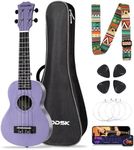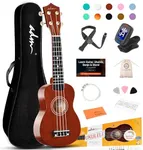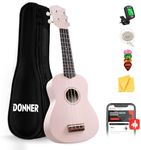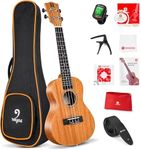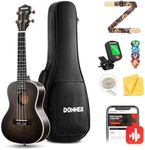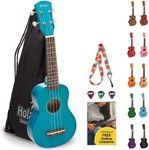Buying Guide for the Best Ukulele For Kids
Choosing the right ukulele for kids can be a fun and rewarding experience. The right instrument can inspire a lifelong love of music and make learning enjoyable. When selecting a ukulele for a child, it's important to consider factors such as size, material, sound quality, and ease of play. Understanding these key specifications will help you make an informed decision and find the best fit for your young musician.SizeUkuleles come in different sizes, with the soprano, concert, and tenor being the most common for kids. The size of the ukulele affects both the sound and the playability. Soprano ukuleles are the smallest and most suitable for younger children due to their small hands. Concert ukuleles are slightly larger and may be a good choice for older kids or those who find the soprano too cramped. Tenor ukuleles are larger still and offer a deeper sound, but they may be too big for very young children. Choose a size that your child can comfortably hold and play.
MaterialUkuleles can be made from various materials, including wood, laminate, and plastic. The material affects the sound quality and durability of the instrument. Wooden ukuleles, especially those made from solid wood, tend to produce a richer, warmer sound but can be more expensive and delicate. Laminate ukuleles are more affordable and durable, making them a good choice for kids who might be rough with their instruments. Plastic ukuleles are the most durable and often waterproof, making them ideal for very young children or for use in outdoor settings. Consider your child's age, playing environment, and how careful they are with their belongings when choosing the material.
Sound QualityThe sound quality of a ukulele is influenced by its size, material, and construction. A good-sounding ukulele will encourage your child to play more and enjoy the learning process. Soprano ukuleles have a bright, cheerful sound, while concert and tenor ukuleles offer a fuller, richer tone. Wooden ukuleles generally provide better sound quality than laminate or plastic ones. When possible, listen to the ukulele being played before purchasing to ensure it has a pleasing sound. If buying online, read reviews and watch videos to get an idea of the instrument's sound.
Ease of PlayFor kids, it's crucial that the ukulele is easy to play. This includes having a comfortable neck, smooth frets, and strings that are not too hard to press down. A ukulele that is difficult to play can be discouraging for a child. Look for a ukulele with a low action (the distance between the strings and the fretboard) as this makes it easier to press the strings. Additionally, consider the weight of the ukulele; a lighter instrument will be easier for a child to hold and play for extended periods. Ensure the ukulele is well-constructed and set up properly to provide a positive playing experience.
Design and ColorThe design and color of the ukulele can make it more appealing to a child. Ukuleles come in a variety of colors and designs, from traditional wood finishes to bright, fun colors and patterns. Choosing a ukulele that reflects your child's personality and interests can make them more excited about playing. While the design is not as crucial as other factors like size and sound quality, it can play a role in motivating your child to pick up the instrument and practice regularly. Let your child have a say in the design to ensure they feel a personal connection to their ukulele.
